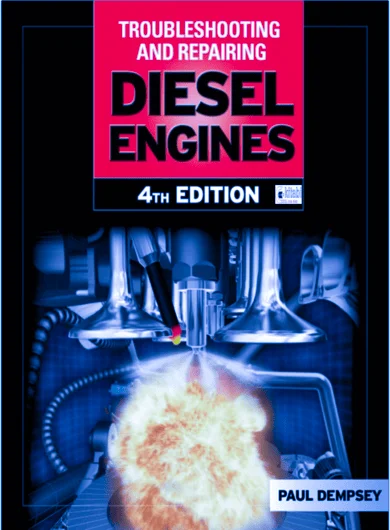Troubleshooting and Repairing Diesel Engines 4th Edition- PDF

Diesel engines are powerful and efficient. Keeping them in top shape requires specialized knowledge. Understanding how these engines work helps avoid costly repairs and dangerous issues. Let’s explore the ins and outs of troubleshooting and repairing diesel engines.
Understanding Diesel Engine Fundamentals
Key Components and Their Functions
Diesel engines consist of several important parts:
- Fuel Injection System: Delivers the right amount of fuel to the engine.
- Turbocharger: Boosts engine power by increasing air intake.
- Crankshaft: Converts linear motion into rotational motion.
Visual aids, like diagrams, can enhance understanding of these components and how they interact.
Common Diesel Engine Problems and Their Causes
Diesel engine problems are not uncommon. Some typical issues include:
- Hard starting
- Excess smoke
- Loss of power
Reports suggest that nearly 50% of diesel engine failures arise from fuel system issues. For instance, a clogged fuel filter can lead to power loss, while faulty injectors can create a smoky exhaust.
Diagnosing Diesel Engine Issues: A Step-by-Step Approach
Visual Inspection and Basic Checks
Start with a thorough visual check. Here’s what to look for:
- Fluid Levels: Ensure oil, coolant, and fuel are at proper levels.
- Leaks: Look under the engine for puddles or stains.
- Signs of Damage: Check for cracks or corrosion on engine parts.
Noticing white smoke? This often points to a coolant leak, while black smoke can indicate too much fuel is entering the engine.
Advanced Diagnostic Techniques
For deeper issues, use diagnostic tools. Key techniques include:
- Scan Tools: Read error codes from the engine control unit (ECU).
- Pressure Gauges: Measure oil pressure or boost pressure from the turbocharger.
Interpreting these codes accurately can reveal underlying problems that a visual check might miss.
Repairing Common Diesel Engine Problems
Fuel System Troubleshooting and Repair
Fuel system troubles are frequent in diesel engines. Here’s how to address them:
- Clogged Fuel Filter: Replace regularly to ensure clean fuel flow.
- Faulty Injectors: Clean or replace injectors as needed. Experts recommend ultrasonic cleaning for effective results, removing deposits that can impact performance.
Turbocharger Repair and Replacement
If you experience a loss of power or hear unusual noises, your turbocharger might be the problem. Signs include:
- Excessive whining noises
- Smoke from the exhaust
Repair typically involves cleaning or replacing the unit. If replacement is necessary, choose a turbo that matches the engine specifications carefully.
Engine Electrical System Diagnosis and Repair
Electrical issues can also plague diesel engines. To diagnose:
- Check Sensors: Verify sensor readings with a multimeter.
- Inspect Wiring: Look for frayed wires or poor connections.
Safety is critical. Always disconnect the battery when working on electrical components to avoid shocks.
Preventive Maintenance for Diesel Engines
Regular Maintenance Schedule
Preventive maintenance saves time and money. Here’s a basic schedule:
- Oil Changes: Every 3,000 to 5,000 miles.
- Filter Replacements: Every 10,000 miles.
- Inspect Belts and Hoses: Every 6 months.
Regular maintenance helps extend engine life and reduce the chance of emergencies.
Choosing the Right Fluids and Lubricants
Fluids matter. Using the correct engine oil and coolant is vital. Here’s what to keep in mind:
- Engine Oil: Choose oil with the right viscosity for your engine.
- Coolant: Use manufacturer-recommended coolant to prevent overheating.
Incorrect fluids can lead to significant engine damage over time, leading to costly repairs.
Conclusion: Maintaining Peak Diesel Performance
In summary, diesel engines require specialized care. Regular maintenance and prompt diagnosis of issues can significantly enhance performance and longevity. Don’t hesitate to seek professional help when needed. Use this guide to ensure your diesel engine remains in peak condition. Keep your engine running smoothly, and enjoy the power and efficiency that a well-maintained diesel engine provides.
About The Book
Latest Tools and Techniques for Troubleshooting and Repairing Diesel Engines.
The fourth edition of Troubleshooting and Repairing Diesel Engines presents the latest advances in diesel technology. Comprehensive and practical, this revised edition gives you all the cutting-edge tools and techniques you need to keep your diesel engine running in top condition.
Written by master mechanic and best-selling author Paul Dempsey, this practical resource covers new engine technology, electronic engine management, biodiesel fuel, and emissions control. It also includes state-of-the-art information on diagnostics, fuel systems, mechanical governors, electronic governors, cylinder heads, valves, engine mechanics, turbochargers, electrical fundamentals, starters, generators, cooling systems, exhaust after treatment, and much more Over 350 drawings, schematics, and photographs throughout The latest edition of Troubleshooting and Repairing Diesel Engines features:
- New material on biodiesel and straight vegetable oil fuels.
- Intensive review of troubleshooting procedures.
- New engine repair procedures and tools.
- The latest in turbocharger technology.
- Comprehensive new chapter on troubleshooting and repairing electronic engine management systems.
- New chapter on the global movement toward greener, more environmentally friendly diesel.
Get everything you need to solve diesel problems quickly and easily Rudolph Diesel Basics Engine Installation Fuel Systems Electronic Engine Management Systems Cylinder Heads and Valves Engine Mechanics Turbochargers Electrical Basics Starting and Power Systems Cooling Systems Environmentally Friendly Diesel Engines.
